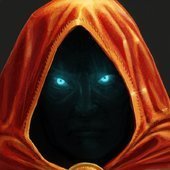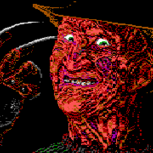-
Posts
7642 -
Joined
-
Last visited
About Koko Ricky
-
Rank
Cosmic Absurdist

Recent Profile Visitors
11510 profile views
-

Did Doom II feel like a slog when it was released?
Koko Ricky replied to princetontiger's topic in Doom General
I'm reminded of how Doom 64 was somewhat derided by the community in the early days, criticized for its pre-rendered fuzziness, monochrome texture sets, and missing enemies. These days, it has a lot more love as well as an active sub-community. -

Did Doom II feel like a slog when it was released?
Koko Ricky replied to princetontiger's topic in Doom General
What seems to rub some people the wrong way about Doom 2's level design is that it leans more into individual concepts and experiments, rather than a cohesive, broader world that feels interconnected. Doom's original shareware episode, while its maps lack consistency between the names, their appearance in the intermission screen, and their actual geometry, feel like a series of manmade locations that are slowly being transformed into something otherworldly and hellish. Being that they share a lot of textures, and the intermission's implication of progression, it has led some to the opinion that Doom 1 is a tighter and more thematically sound experience. The way I see it, as soon as you get into the second episode, Doom begins to lean more toward the conceptual and experimental, much in the way Doom 2 does. Then there's Thy Flesh Consumed, the 4th episode that was added later and not only lacks an intermission screen, but is perfectly content doing its own thing. Doom 2 has a lot more brown, its city maps feel more abstract than representational, and there's no strong sense of progressing toward an end goal; just a bunch of maps, and then it ends. But is that not how the OG Dooms are? -
Or, for people like me, it's just boring. I don't really vibe with the riffs or really anything musical in that album. Then again, Metallica's style in general doesn't seem to tickle anything for me.
-
id Software doesn't do the same game twice. Each Doom feels different than the previous; even Doom 2 has a level design philosophy that feels very different to the original. If they were to go back to an older style of graphics for a new Doom or Quake, it would have to be because there was a motivated reason for doing so. And what would that be? If they want each game to be different, what would make Doom or Quake different to return to their original visual style?
-
It feels like a bunch of other stuff that's been around for decades. I pretty much completely failed to resonate with it.
-

Have you experienced anthing paranormal?
Koko Ricky replied to Sonikkumania's topic in Everything Else
In 2001, I woke up around three in the morning And saw a figure in a white gown, walking down the hallway toward my open bedroom door. At first I thought it was my mom, but as she got closer, I noticed the neck was just a stump with no head... And yet this figure seemed to be staring at me and then just faded away. I remember getting up and walking down the hallway after to prove to myself that I was awake and not dreaming. Somewhere in the late 2010s, my wife and I were both sober and in the kitchen. Between blinks, The entire kitchen floor was covered uniformly with live maggots, all in one instant. The house was not particularly dirty and even if it were, there's no way that the spread of the maggots would be so equal. I remember freaking out and quickly cleaning up. -
I've developed a mild addiction to it, in the sense that I return to it under any and all circumstances, whereas I used to break from it once and awhile. Two decades ago, I was diagnosed with bipolar disorder, and I find that getting stoned helps even out my mood, whereas none of the medication I took in the past seemed to be of any positive benefit. Of course, smoking too much can make me feel physically and mentally unpleasant, so it's a balance. Not smoking at all tends to make me a lot more easily stressed and moody. Sometimes, I miss having that balance, where I would go a bit without smoking, and then return to it. But life is more complex these days, and my body pains are of significant enough import that I need a lot of stress relief, something that pain pills don't always provide. I stay stoned basically 24/7 and budget things carefully so I don't overspend.
-
Water physics slow down player movement. When most of the game is at a much faster pace, water sections can feel like an unnecessary drop-off in the action. However, Hydrocity Zone in Sonic 3 works really well because you can opt out of the water in a number of places.
-

Thought experiment on the paradox of nothingness
Koko Ricky replied to Koko Ricky's topic in Everything Else
I think some of you are conflating "extremely large data set" with "infinite data set" in terms of finding the "bottom layer." An infinite data set would involve infinite regression, but we seem to encounter simpler and simpler systems as we zoom in. In my opinion, running out of information feels more plausible than there being more complexity underneath, because so far everything tells us that any given system becomes less complex as it is probed. That doesn't mean this assumption is correct--not by a longshot--but I cannot think of a reason why you wouldn't run out of information after repeated probing. Therein lies the paradox--if you eventually reach nothing, you cannot power the universe on nothing. Or at least it doesn't seem that way. I'm certainly open to the idea that more secret layers are currently hidden from view. -

Thought experiment on the paradox of nothingness
Koko Ricky replied to Koko Ricky's topic in Everything Else
I'm not sure I absolutely believe that assumption. Quantum mechanics implies that, and it is the single most accurate scientific theory ever, but we also know it's incomplete. At the same time, an intuition tells me that we should eventually run out of information in describing any given system. If it were infinite, then there should never be any shortage of available energy. -

Thought experiment on the paradox of nothingness
Koko Ricky replied to Koko Ricky's topic in Everything Else
What is the correlation between my diatribe on nothingness and vaping? Are you talking about nicotine? -

Thought experiment on the paradox of nothingness
Koko Ricky replied to Koko Ricky's topic in Everything Else
The paradox is that you run out of information the more you zoom in to something. If we zoom into a JPG, eventually the entire screen is occupied by a single pixel; no further division is possible. The Planck spaces of quantum mechanics are analogous to pixels in that our current ruleset prevents further division, as though we hit the basement level. If nothing is beyond such a point, it would make no sense, since we intuit every layer to have components in a lower layer. But, proposing that implies infinite regression, which we don't intuit because we want there to be a way to account for an infinite amount of available information. It doesn't work either way. Now, I don't doubt there is an error in the math, as quantum mechanics is incomplete--there's not even accounting for gravity in quantum theory--but this is definitely a paradox because everything emerging from a nothing state doesn't fit our logic, and neither does an infinite regression of ever-smaller components. -

Thought experiment on the paradox of nothingness
Koko Ricky replied to Koko Ricky's topic in Everything Else
This perspective comes from about two decades of hobbyist research into quantum mechanics and physics, so if you want what I'm having, look into those topics. -
If we take me, as a singular entity, we can say that I comprise a complex system of various interacting atoms. If we strip down to just a single hydrogen atom, we lose quite a bit of information, reducing our system now to just a single electron, a single proton, and their properties. We eliminate more information by zooming in and focusing on the proton. If we crack it open, a quark-gluon plasma can be detected, and we were able to crack that open, we might find the theoretical strings of string theory; one-dimensional filaments vibrating in a high-dimensional membrane. However, the string is already one-dimensional; there's not really a way to break it down further that we know of. In a sense, at this point you run out of properties by which to describe something. The more we zoom in, the less information is present. It would almost seem as though attempting to dissect the string would show us nothing at all, as quantum mechanics implies that there isn't really anything physical that can be detected at small enough scales, with strings supposedly occupying that scale space. The great contradiction here is that, if there is nothing to be found by zooming all the way in, then something must account for there being a starting point at which properties (such as spin, mass, charge, etc.) begin to emerge. However, while emergence from nothingness causes thinky brain pain, the same is true for proposing any starting point, as we naturally want there to be a mechanism that allows the starting point to emerge. Thus, there is a paradox of nothingness here; asserting nothing at the bottom layer feels as mysterious a proposition as asserting a starting point. EDIT: A third and equally frustrating potential is infinite regression, where any starting point can be preceded by an even smaller starting point, embedded inside the larger one.
-

Game that everybody likes but you dislike
Koko Ricky replied to Ralseiwithagun's topic in Everything Else
This likely applies here more than other spaces, but Wolfenstein 3D fucking sucks. I played it back in '93 and loved it, but rarely returned to it once Doom, Build shooters and Quake became a thing. It has the same fundamental problem as platformers before the advent of complex surfaces: you're bound to a grid, so there's almost no potential for topographical variety. id Software managed a competent game, but not a particularly fun one. In addition to its sterile, boring level design, barebones interaction, and plain look, the controls are a product of their time and thus actually moving and engaging with combat is awkward and irritating. 1992 just wasn't the time to do this. Personal computers had to do everything through software, and without sufficient clockspeed or RAM, your "3D" game had to be significantly scaled back.
















